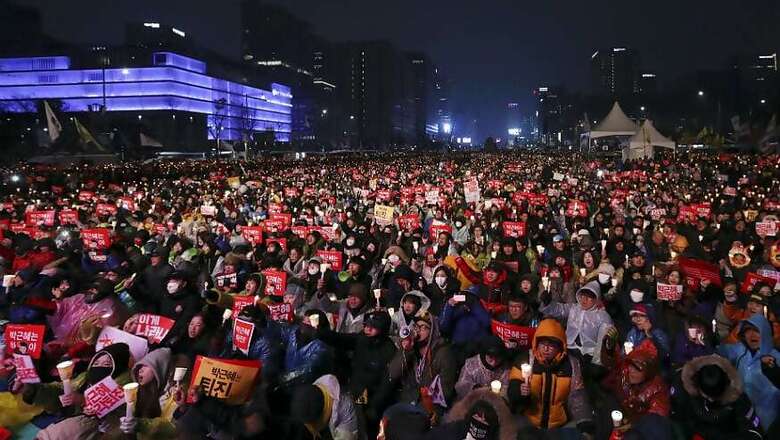
views
Seoul: When South Korean students protested in the 1960s and 1980s, blood flowed in the streets. In 2016, children launch flashing toys into the night air as entertainers lead a massive, docile crowd in popular sing-alongs.
This striking contrast — from hand-to-hand combat to scenes out of Disney — represents an accomplishment for South Korea, a democracy that was a dictatorship not too long ago and where social and political divisions still run deep.
But the current protests to force President Park Geun-hye from power over allegations she let a corrupt confidante pull government strings share an important quality with what came before: Now, as then, a popular movement is on the verge of pushing out a deeply unpopular leader.
That this peaceful, compartmentalized (mostly Saturdays, from around noon to midnight) uprising looks set to succeed is something of a surprise in a country with a long history of messy, often violent resistance.
Just last year, protests against Park saw buses toppled and vandalized and a farmer get blasted with a water cannon and later die. Demonstrators in recent years have driven trucks into the gates of the Japanese Embassy, and lopped off their fingers in nearby streets, to protest territorial and historical disputes with Tokyo. The current U.S. ambassador's face was slashed last year by a South Korean activist.
In 1960 and the 1980s, often-violent mass protests forced one authoritarian leader to flee and a dictatorship to allow democratic elections.
The recent demonstrations have seen a collective effort at something novel: docility.
Protesters plaster ubiquitous police buses with flower stickers. When some have climbed on the buses, they've been admonished by others to get down and be peaceful.
Social media have played a part.
People have taken to Facebook and other platforms to encourage each other to protest calmly so they can bring their children to witness a part of history.
On the second Saturday protest, when organizers announced they would march toward the Blue House, many questioned online whether demonstrators risked violence by confronting the mass of police who would be guarding the president's residence and office. This forced organizers to make an additional pledge to demonstrate peacefully.
The authorities have also helped.
Court decisions forced the opening of streets closer to the Blue House where police had blocked protesters last year when violence erupted. Police have also avoided aggressive crowd control measures such as pepper spray and water cannons.
The labor and civic groups who organize the rallies have decided to use sheer numbers, not violence, to try to force Park out. So far, it has worked. Each Saturday for the last five weeks, the protests have drawn hundreds of thousands — organizers put last Saturday's crowd at 1.5 million.
To peel away such huge numbers from the delights of modern South Korean society — movie theaters, cafes, the comforts of warm, digitized homes — organizers have sought to appeal to families.
Vendors hawk plastic horns, toys, hotdogs and fish sticks. People set up picnic blankets and plastic mattresses beneath the stars.
Actors impersonating Park and her confidante, Choi Soon-sil, walk through the crowd, encouraging people to mock them. Children throw bean bags at Park pinatas and draw crayon caricatures of Park with captions that read, "Park Geun-hye, boo!"
Entertainers on a huge stage keep people occupied with folk songs and instructions on how to move their candles and anti-Park placards in unison. Giant speakers are so loud that people have trouble talking to one another, even blocks away from the main stage.
This isn't to say that there's been a complete absence of violence since the scandal broke.
Police say a man drove a piece of construction equipment into the gate of the Seoul prosecutors' office in anger over the allegations against Park. And a man was arrested this week for allegedly burning the birthplace of Park's late dictator father, Park Chung-hee, because she refused to immediately step down.
The main protests, however, have been both peaceful and startlingly effective.
When the rallies began, politicians worried about pushing for Park's resignation, let alone impeachment, fearful that they would make the president look more victim than tyrant and, through their aggressiveness, sway the course of next year's presidential election.
But the huge crowds emboldened lawmakers to seek an impeachment vote, although Park has slowed that effort with a recent offer to resign if parliament can set up a path to peacefully hand over power. Lawmakers still plan to vote on impeachment next week, and many believe that Park won't be able to serve out her single five-year term, which ends in early 2018.
Even so, there's some worry among organizers that the longer Park clings to power, the harder it will be to draw huge crowds.
Less people could mean rising frustration among hardcore union and civic groups who could then step up their aggression toward police. This is what happened in 2008 when massive crowds came out to protest US beef imports amid unfounded fears of mad cow disease.
For now, however, the soundtrack of defiance at these protests has been a multitude of voices lifted together in song, not rage, and the laughter of children playing at their parents' feet.




















Comments
0 comment